towing TOYOTA VERSO 2015 Owners Manual
[x] Cancel search | Manufacturer: TOYOTA, Model Year: 2015, Model line: VERSO, Model: TOYOTA VERSO 2015Pages: 650, PDF Size: 36.61 MB
Page 3 of 650
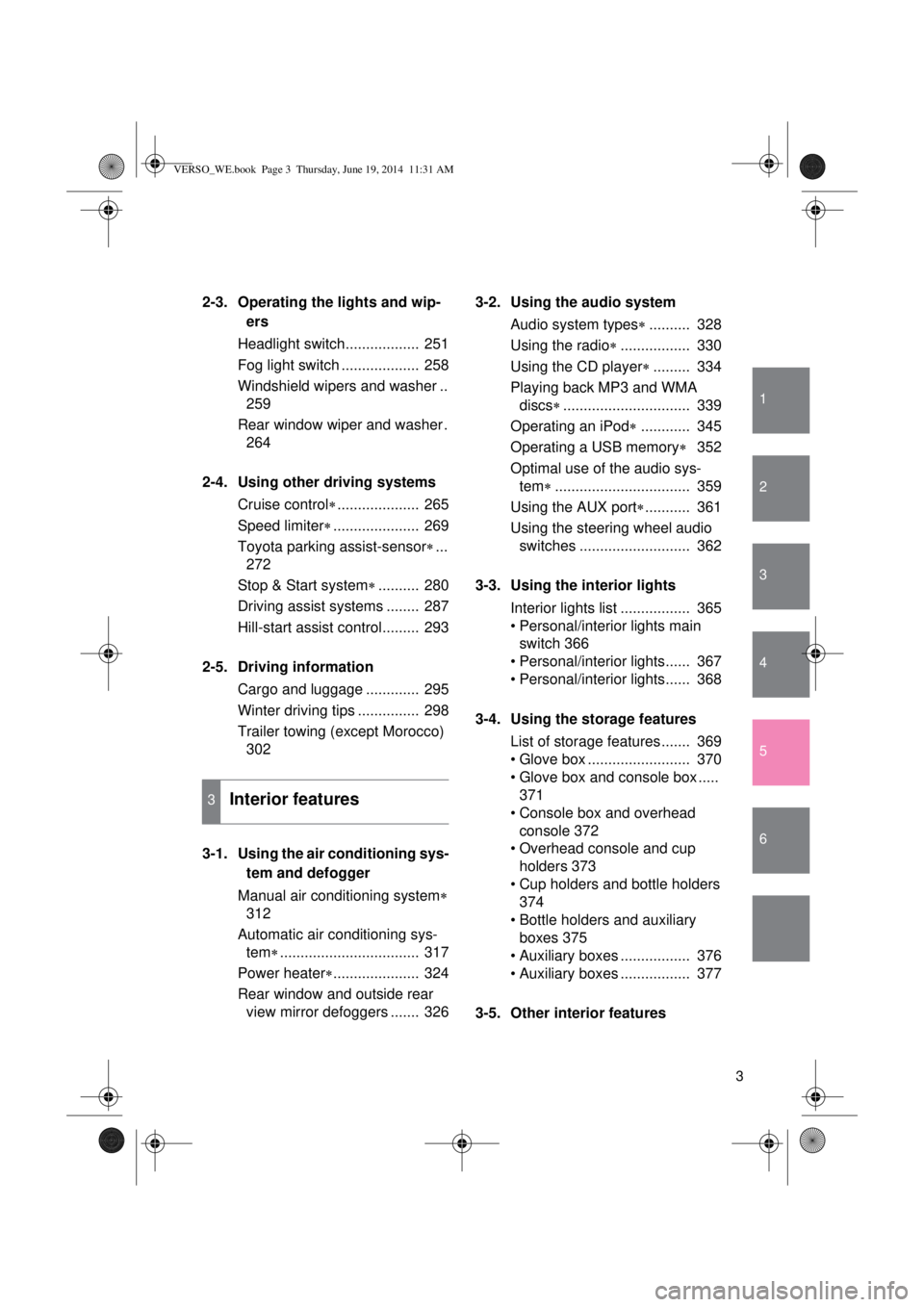
1
2
3
4
5
6
3
2-3. Operating the lights and wip-
ers
Headlight switch.................. 251
Fog light switch ................... 258
Windshield wipers and washer ..
259
Rear window wiper and washer .
264
2-4. Using other driving systems
Cruise control.................... 265
Speed limiter..................... 269
Toyota parking assist-sensor...
272
Stop & Start system.......... 280
Driving assist systems ........ 287
Hill-start assist control......... 293
2-5. Driving information
Cargo and luggage ............. 295
Winter driving tips ............... 298
Trailer towing (except Morocco)
302
3-1. Using the air conditioning sys-
tem and defogger
Manual air conditioning system
312
Automatic air conditioning sys-
tem.................................. 317
Power heater..................... 324
Rear window and outside rear
view mirror defoggers ....... 3263-2. Using the audio system
Audio system types.......... 328
Using the radio................. 330
Using the CD player......... 334
Playing back MP3 and WMA
discs............................... 339
Operating an iPod............ 345
Operating a USB memory 352
Optimal use of the audio sys-
tem................................. 359
Using the AUX port........... 361
Using the steering wheel audio
switches ........................... 362
3-3. Using the interior lights
Interior lights list ................. 365
• Personal/interior lights main
switch 366
• Personal/interior lights...... 367
• Personal/interior lights...... 368
3-4. Using the storage features
List of storage features....... 369
• Glove box ......................... 370
• Glove box and console box .....
371
• Console box and overhead
console 372
• Overhead console and cup
holders 373
• Cup holders and bottle holders
374
• Bottle holders and auxiliary
boxes 375
• Auxiliary boxes ................. 376
• Auxiliary boxes ................. 377
3-5. Other interior features
3Interior features
VERSO_WE.book Page 3 Thursday, June 19, 2014 11:31 AM
Page 93 of 650
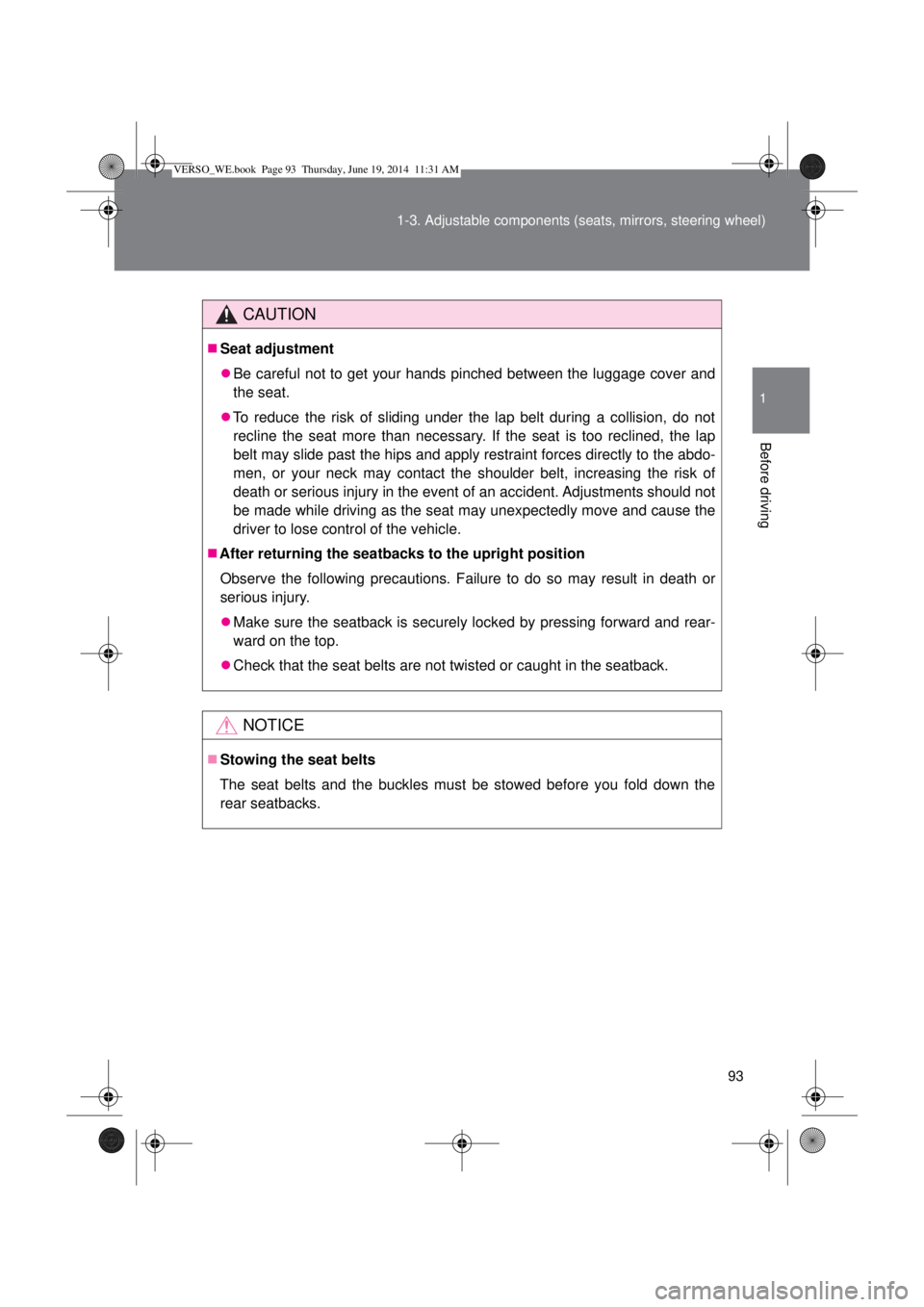
93 1-3. Adjustable components (seats, mirrors, steering wheel)
1
Before driving
CAUTION
Seat adjustment
Be careful not to get your hands pinched between the luggage cover and
the seat.
To reduce the risk of sliding under the lap belt during a collision, do not
recline the seat more than necessary. If the seat is too reclined, the lap
belt may slide past the hips and apply restraint forces directly to the abdo-
men, or your neck may contact the shoulder belt, increasing the risk of
death or serious injury in the event of an accident. Adjustments should not
be made while driving as the seat may unexpectedly move and cause the
driver to lose control of the vehicle.
After returning the seatbacks to the upright position
Observe the following precautions. Failure to do so may result in death or
serious injury.
Make sure the seatback is securely locked by pressing forward and rear-
ward on the top.
Check that the seat belts are not twisted or caught in the seatback.
NOTICE
Stowing the seat belts
The seat belts and the buckles must be stowed before you fold down the
rear seatbacks.
VERSO_WE.book Page 93 Thursday, June 19, 2014 11:31 AM
Page 181 of 650
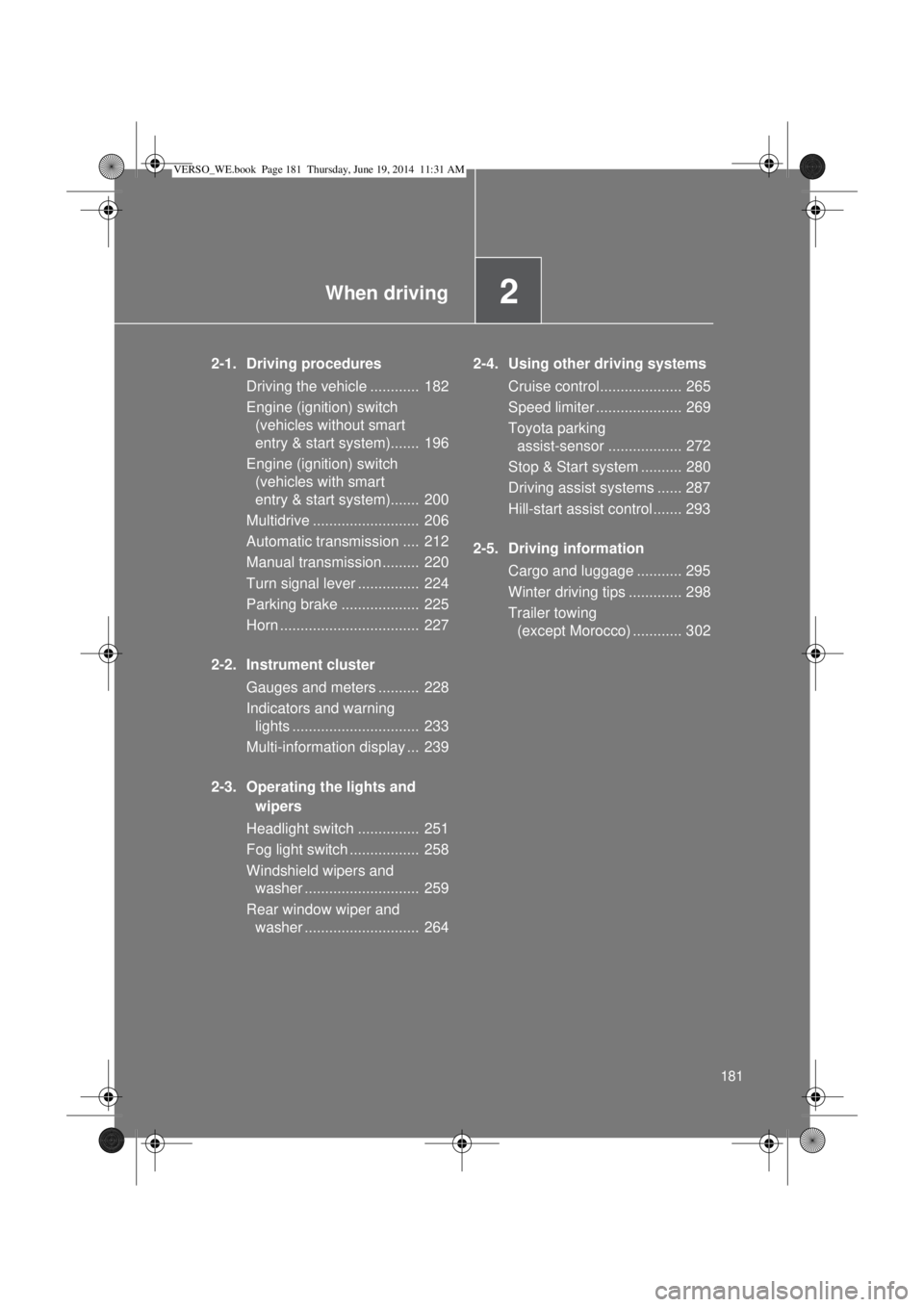
2When driving
181
2-1. Driving procedures
Driving the vehicle ............ 182
Engine (ignition) switch
(vehicles without smart
entry & start system)....... 196
Engine (ignition) switch
(vehicles with smart
entry & start system)....... 200
Multidrive .......................... 206
Automatic transmission .... 212
Manual transmission......... 220
Turn signal lever ............... 224
Parking brake ................... 225
Horn .................................. 227
2-2. Instrument cluster
Gauges and meters .......... 228
Indicators and warning
lights ............................... 233
Multi-information display ... 239
2-3. Operating the lights and
wipers
Headlight switch ............... 251
Fog light switch ................. 258
Windshield wipers and
washer ............................ 259
Rear window wiper and
washer ............................ 2642-4. Using other driving systems
Cruise control.................... 265
Speed limiter ..................... 269
Toyota parking
assist-sensor .................. 272
Stop & Start system .......... 280
Driving assist systems ...... 287
Hill-start assist control....... 293
2-5. Driving information
Cargo and luggage ........... 295
Winter driving tips ............. 298
Trailer towing
(except Morocco) ............ 302
VERSO_WE.book Page 181 Thursday, June 19, 2014 11:31 AM
Page 268 of 650
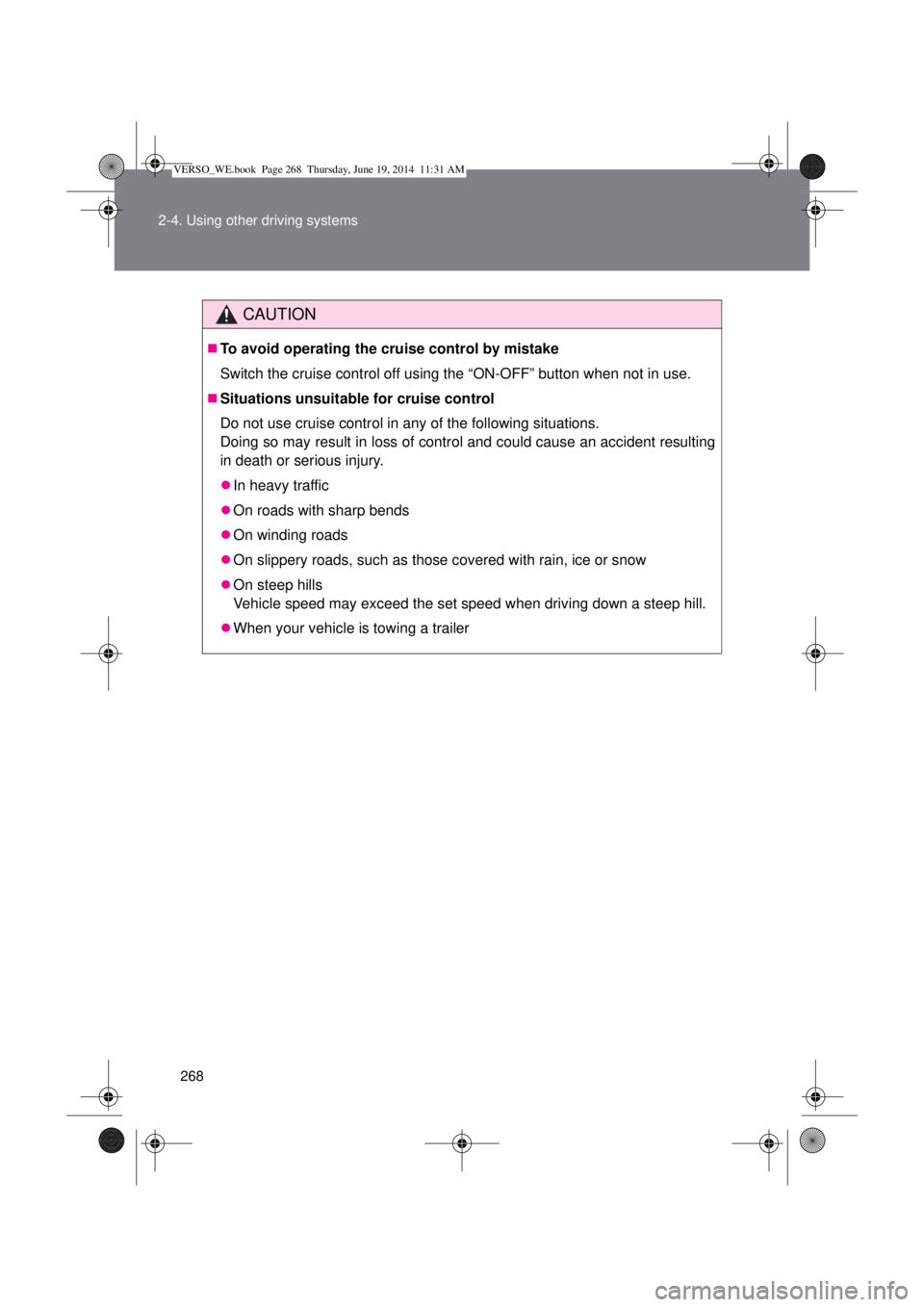
268 2-4. Using other driving systems
CAUTION
To avoid operating the cruise control by mistake
Switch the cruise control off using the “ON-OFF” button when not in use.
Situations unsuitable for cruise control
Do not use cruise control in any of the following situations.
Doing so may result in loss of control and could cause an accident resulting
in death or serious injury.
In heavy traffic
On roads with sharp bends
On winding roads
On slippery roads, such as those covered with rain, ice or snow
On steep hills
Vehicle speed may exceed the set speed when driving down a steep hill.
When your vehicle is towing a trailer
VERSO_WE.book Page 268 Thursday, June 19, 2014 11:31 AM
Page 271 of 650
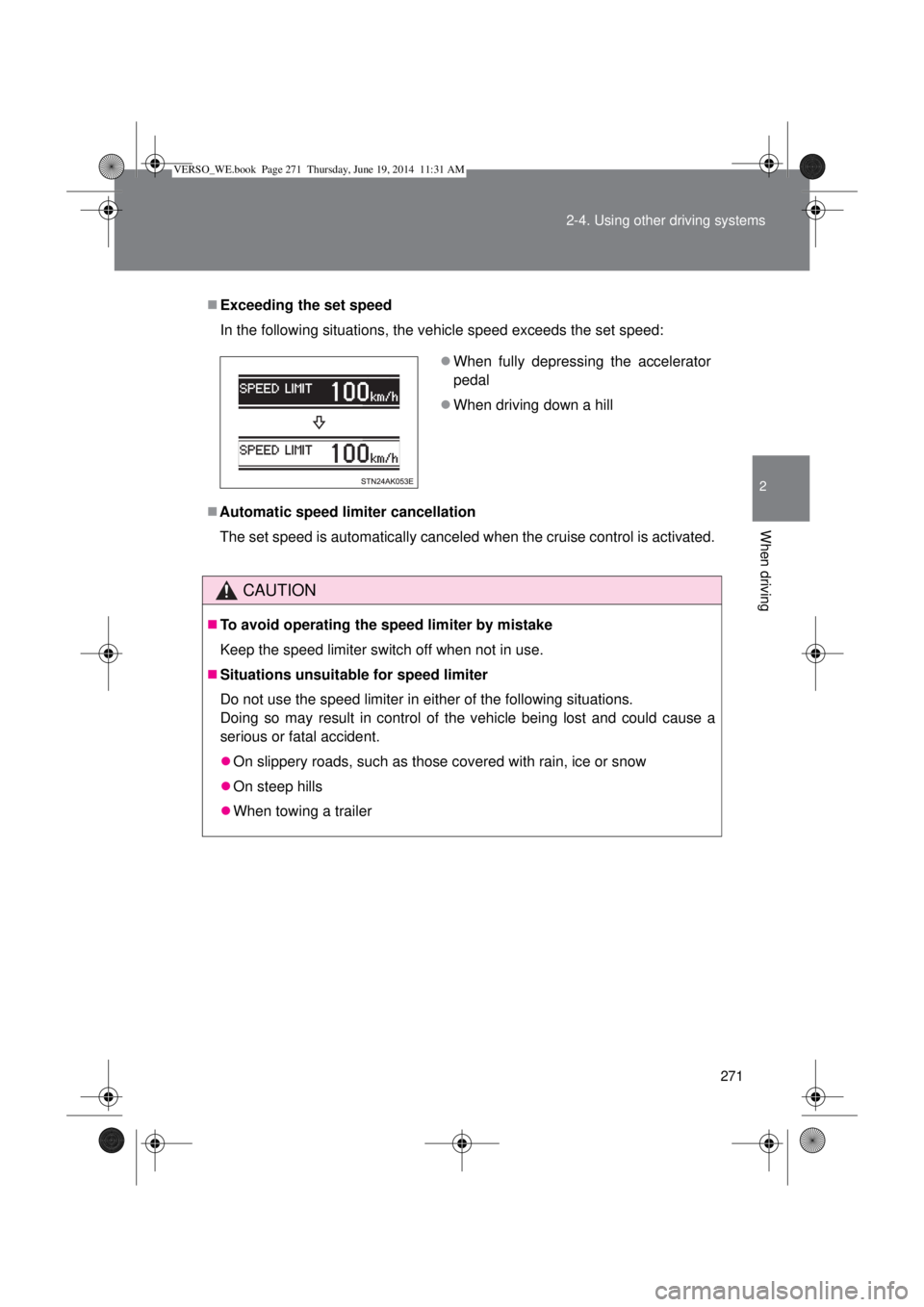
271 2-4. Using other driving systems
2
When driving
Exceeding the set speed
In the following situations, the vehicle speed exceeds the set speed:
Automatic speed limiter cancellation
The set speed is automatically canceled when the cruise control is activated.
CAUTION
To avoid operating the speed limiter by mistake
Keep the speed limiter switch off when not in use.
Situations unsuitable for speed limiter
Do not use the speed limiter in either of the following situations.
Doing so may result in control of the vehicle being lost and could cause a
serious or fatal accident.
On slippery roads, such as those covered with rain, ice or snow
On steep hills
When towing a trailer
When fully depressing the accelerator
pedal
When driving down a hill
VERSO_WE.book Page 271 Thursday, June 19, 2014 11:31 AM
Page 277 of 650
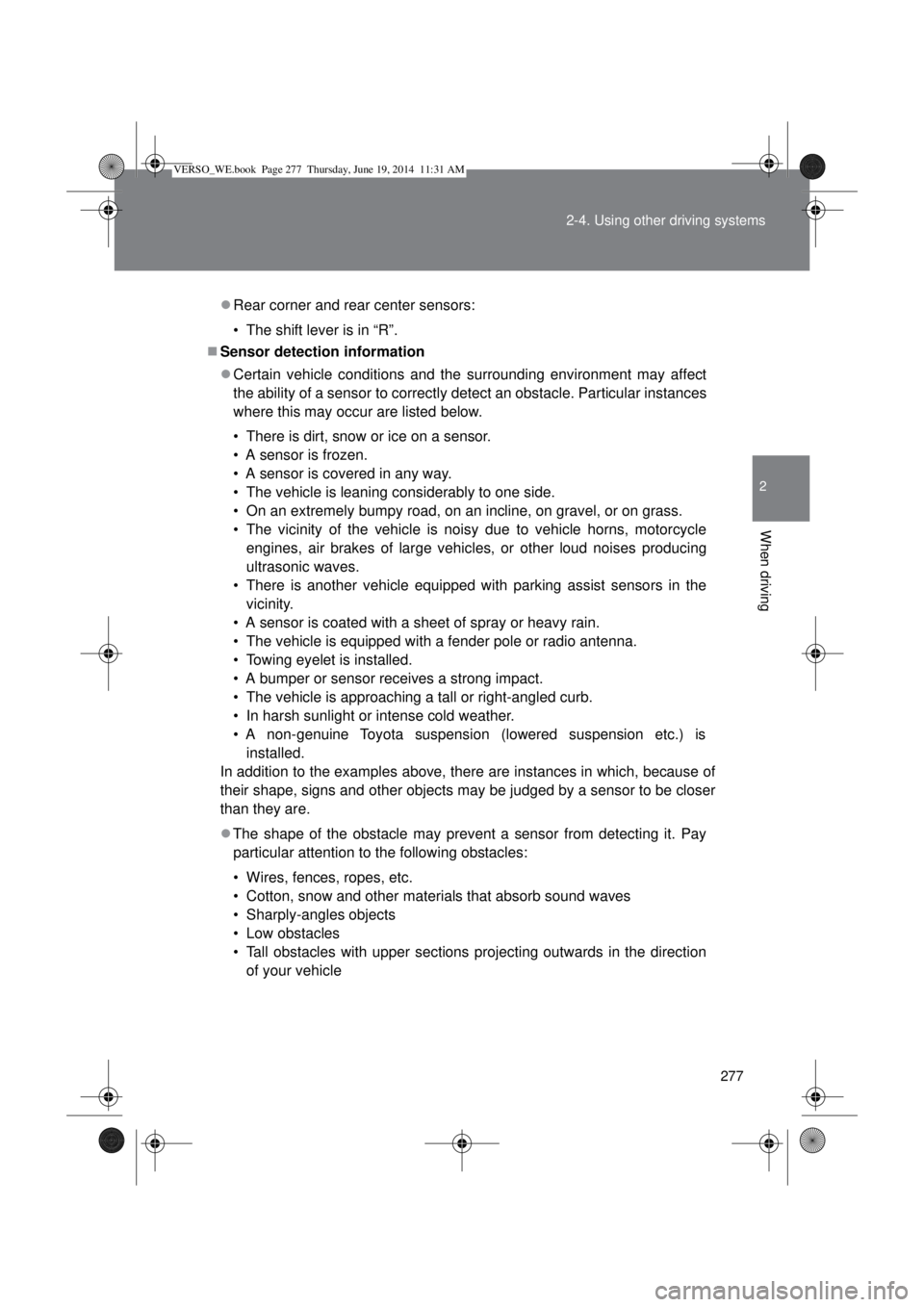
277 2-4. Using other driving systems
2
When driving
Rear corner and rear center sensors:
• The shift lever is in “R”.
Sensor detection information
Certain vehicle conditions and the surrounding environment may affect
the ability of a sensor to correctly detect an obstacle. Particular instances
where this may occur are listed below.
• There is dirt, snow or ice on a sensor.
• A sensor is frozen.
• A sensor is covered in any way.
• The vehicle is leaning considerably to one side.
• On an extremely bumpy road, on an incline, on gravel, or on grass.
• The vicinity of the vehicle is noisy due to vehicle horns, motorcycle
engines, air brakes of large vehicles, or other loud noises producing
ultrasonic waves.
• There is another vehicle equipped with parking assist sensors in the
vicinity.
• A sensor is coated with a sheet of spray or heavy rain.
• The vehicle is equipped with a fender pole or radio antenna.
• Towing eyelet is installed.
• A bumper or sensor receives a strong impact.
• The vehicle is approaching a tall or right-angled curb.
• In harsh sunlight or intense cold weather.
• A non-genuine Toyota suspension (lowered suspension etc.) is
installed.
In addition to the examples above, there are instances in which, because of
their shape, signs and other objects may be judged by a sensor to be closer
than they are.
The shape of the obstacle may prevent a sensor from detecting it. Pay
particular attention to the following obstacles:
• Wires, fences, ropes, etc.
• Cotton, snow and other materials that absorb sound waves
• Sharply-angles objects
• Low obstacles
• Tall obstacles with upper sections projecting outwards in the direction
of your vehicle
VERSO_WE.book Page 277 Thursday, June 19, 2014 11:31 AM
Page 302 of 650
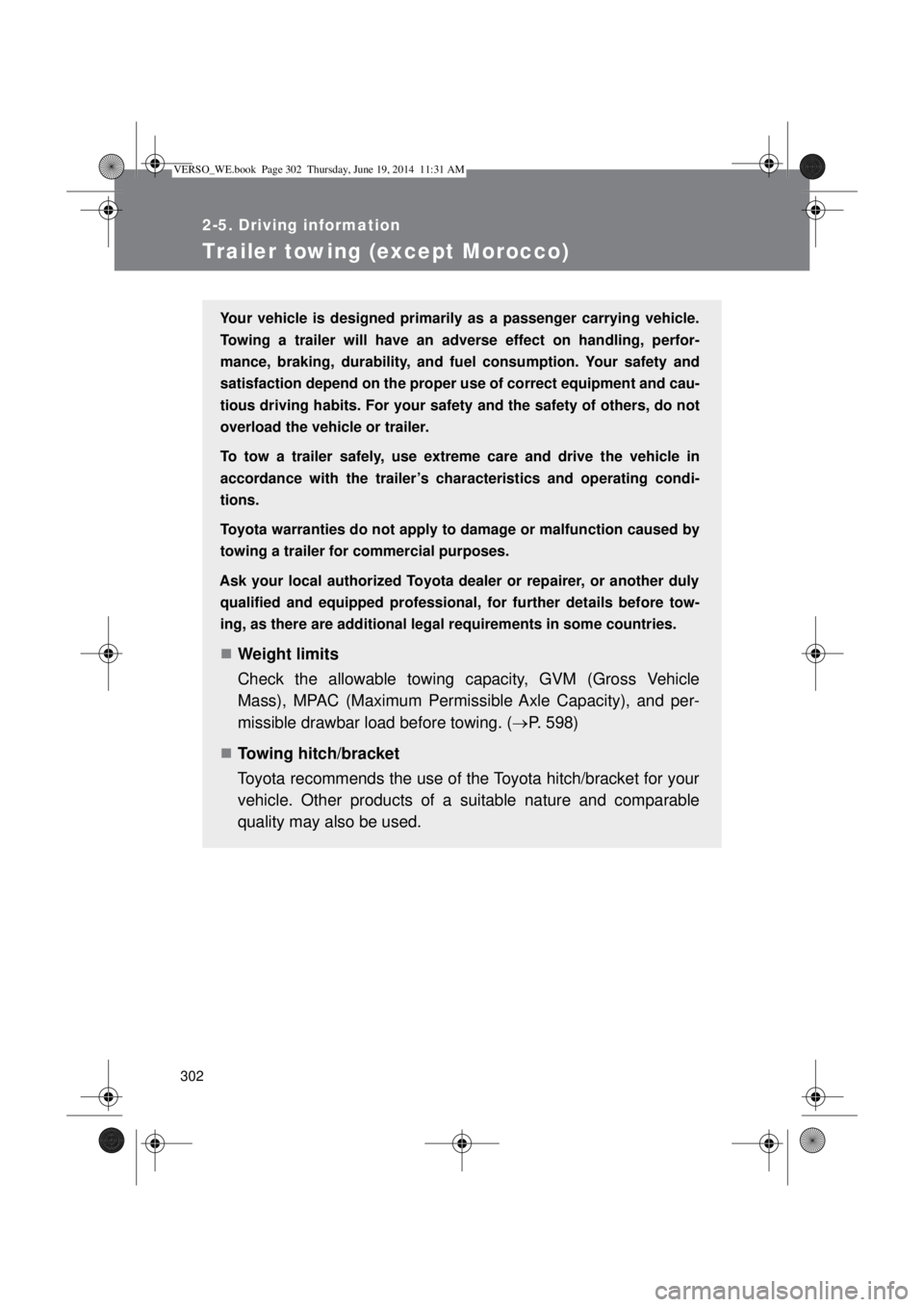
302
2-5. Driving information
Trailer towing (except Morocco)
Your vehicle is designed primarily as a passenger carrying vehicle.
Towing a trailer will have an adverse effect on handling, perfor-
mance, braking, durability, and fuel consumption. Your safety and
satisfaction depend on the proper use of correct equipment and cau-
tious driving habits. For your safety and the safety of others, do not
overload the vehicle or trailer.
To tow a trailer safely, use extreme care and drive the vehicle in
accordance with the trailer’s characteristics and operating condi-
tions.
Toyota warranties do not apply to damage or malfunction caused by
towing a trailer for commercial purposes.
Ask your local authorized Toyota dealer or repairer, or another duly
qualified and equipped professional, for further details before tow-
ing, as there are additional legal requirements in some countries.
Weight limits
Check the allowable towing capacity, GVM (Gross Vehicle
Mass), MPAC (Maximum Permissible Axle Capacity), and per-
missible drawbar load before towing. (P. 598)
Towing hitch/bracket
Toyota recommends the use of the Toyota hitch/bracket for your
vehicle. Other products of a suitable nature and comparable
quality may also be used.
VERSO_WE.book Page 302 Thursday, June 19, 2014 11:31 AM
Page 303 of 650
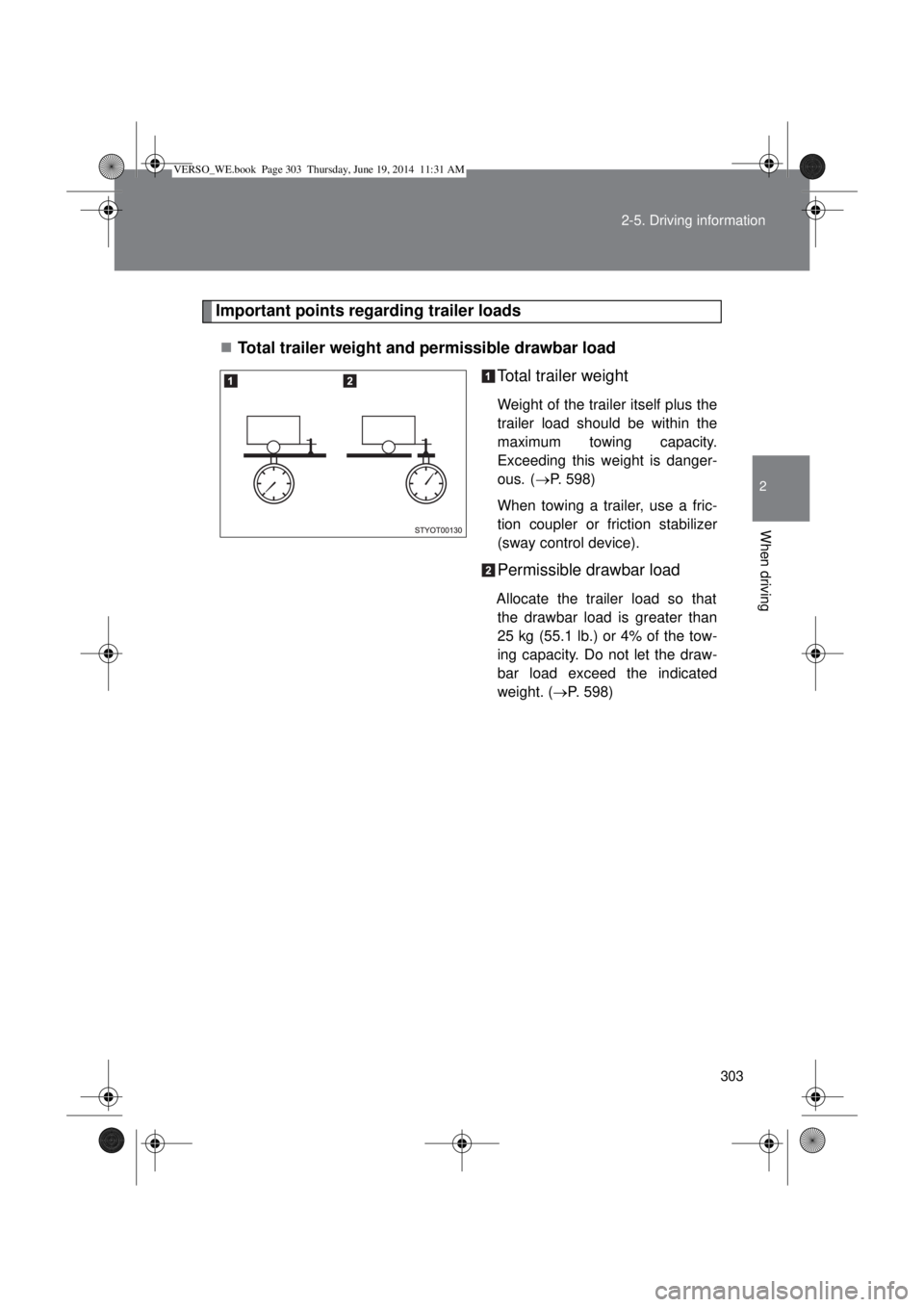
303 2-5. Driving information
2
When driving
Important points regarding trailer loads
Total trailer weight and permissible drawbar load
Total trailer weight
Weight of the trailer itself plus the
trailer load should be within the
maximum towing capacity.
Exceeding this weight is danger-
ous.
(P. 598)
When towing a trailer, use a fric-
tion coupler or friction stabilizer
(sway control device).
Permissible drawbar load
Allocate the trailer load so that
the drawbar load is greater than
25 kg (55.1 lb.) or 4% of the tow-
ing capacity. Do not let the draw-
bar load exceed the indicated
weight. (P. 598)
VERSO_WE.book Page 303 Thursday, June 19, 2014 11:31 AM
Page 304 of 650
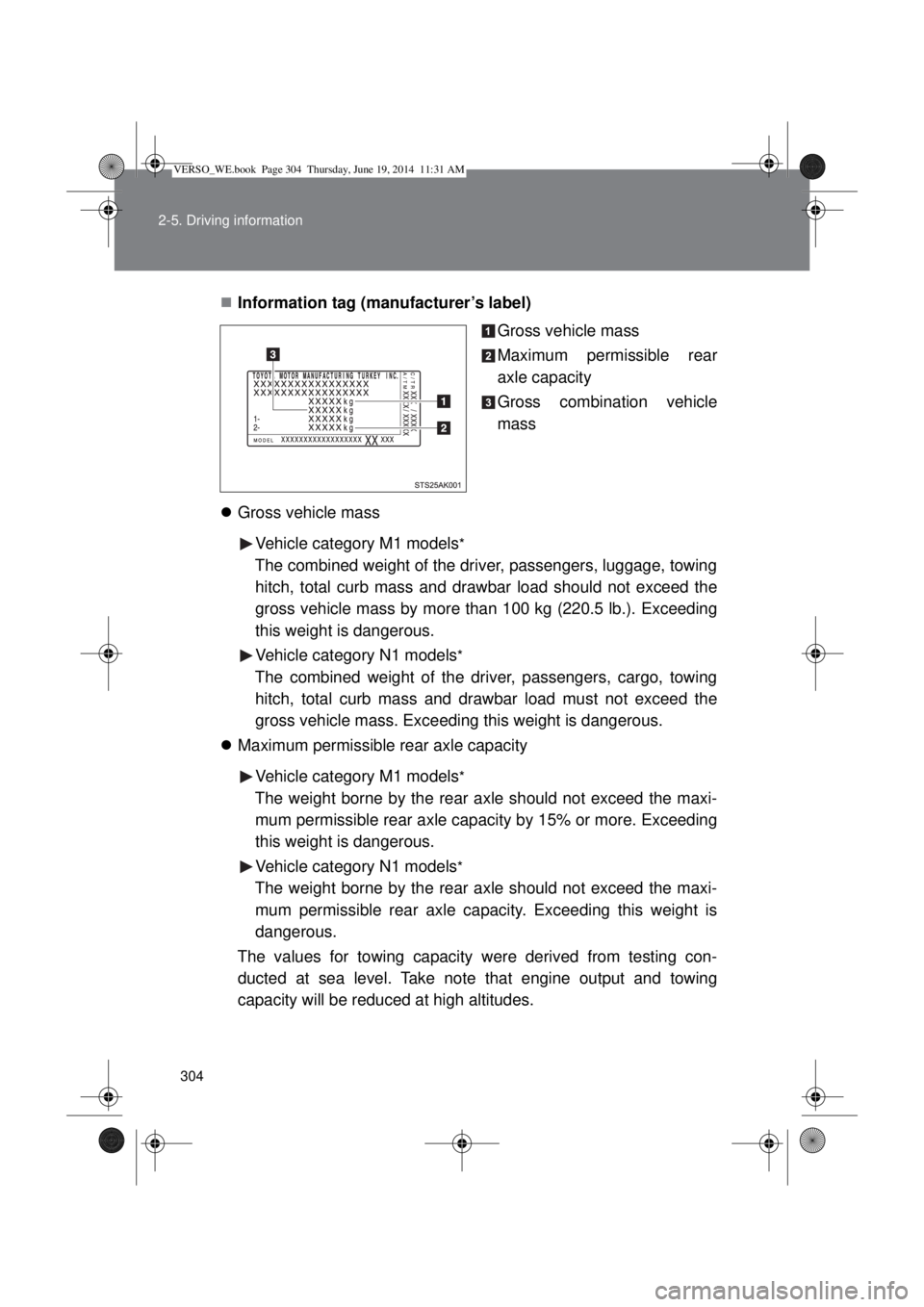
304 2-5. Driving information
Information tag (manufacturer’s label)
Gross vehicle mass
Maximum permissible rear
axle capacity
Gross combination vehicle
mass
Gross vehicle mass
Vehicle category M1 models
*
The combined weight of the driver, passengers, luggage, towing
hitch, total curb mass and drawbar load should not exceed the
gross vehicle mass by more than 100 kg (220.5 lb.). Exceeding
this weight is dangerous.
Vehicle category N1 models
*
The combined weight of the driver, passengers, cargo, towing
hitch, total curb mass and drawbar load must not exceed the
gross vehicle mass. Exceeding this weight is dangerous.
Maximum permissible rear axle capacity
Vehicle category M1 models
*
The weight borne by the rear axle should not exceed the maxi-
mum permissible rear axle capacity by 15% or more. Exceeding
this weight is dangerous.
Vehicle category N1 models
*
The weight borne by the rear axle should not exceed the maxi-
mum permissible rear axle capacity. Exceeding this weight is
dangerous.
The values for towing capacity were derived from testing con-
ducted at sea level. Take note that engine output and towing
capacity will be reduced at high altitudes.
VERSO_WE.book Page 304 Thursday, June 19, 2014 11:31 AM
Page 305 of 650
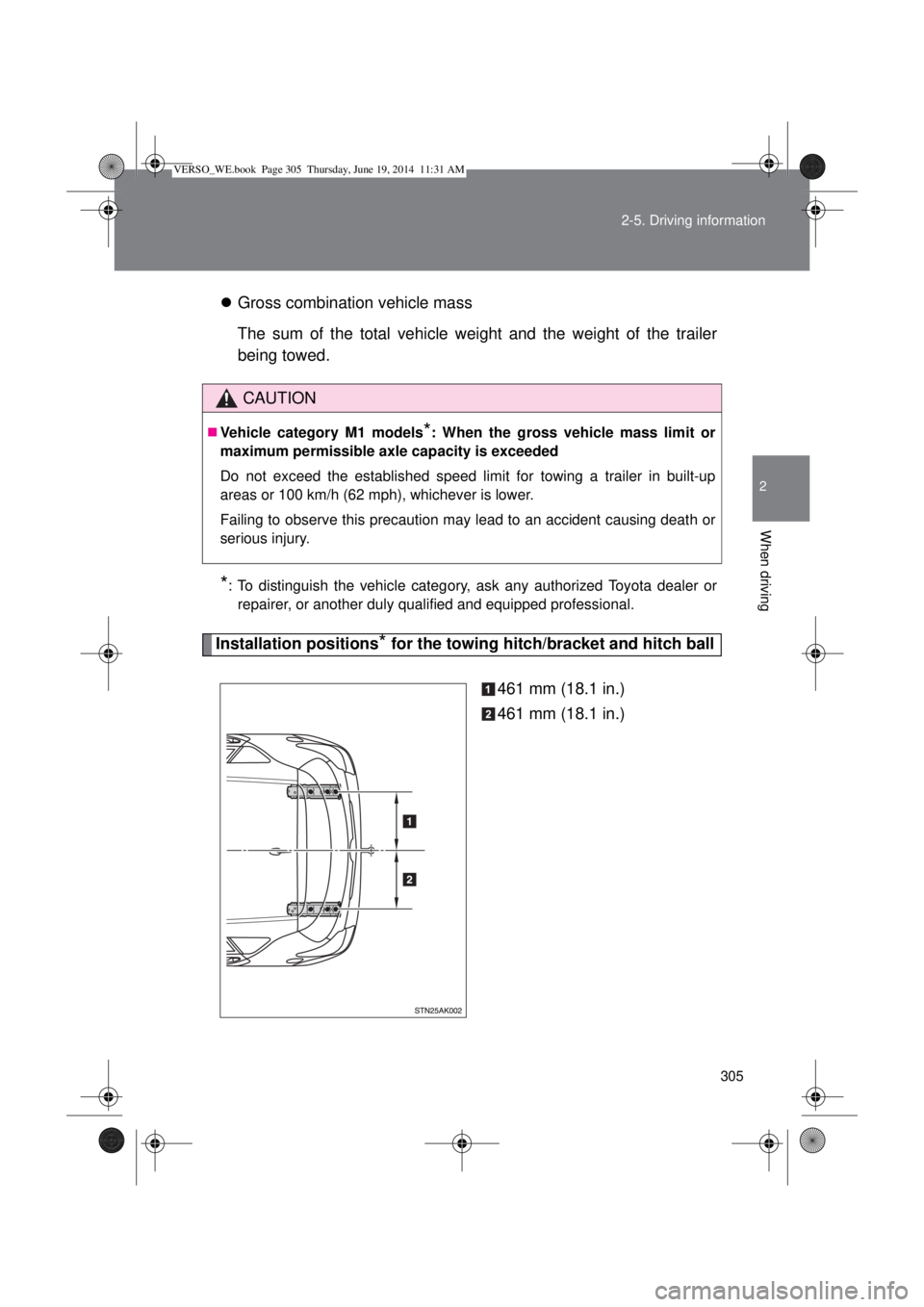
305 2-5. Driving information
2
When driving
Gross combination vehicle mass
The sum of the total vehicle weight and the weight of the trailer
being towed.
*: To distinguish the vehicle category, ask any authorized Toyota dealer or
repairer, or another duly qualified and equipped professional.
Installation positions* for the towing hitch/bracket and hitch ball
461 mm (18.1 in.)
461 mm (18.1 in.)
CAUTION
Vehicle category M1 models*: When the gross vehicle mass limit or
maximum permissible axle capacity is exceeded
Do not exceed the established speed limit for towing a trailer in built-up
areas or 100 km/h (62 mph), whichever is lower.
Failing to observe this precaution may lead to an accident causing death or
serious injury.
VERSO_WE.book Page 305 Thursday, June 19, 2014 11:31 AM